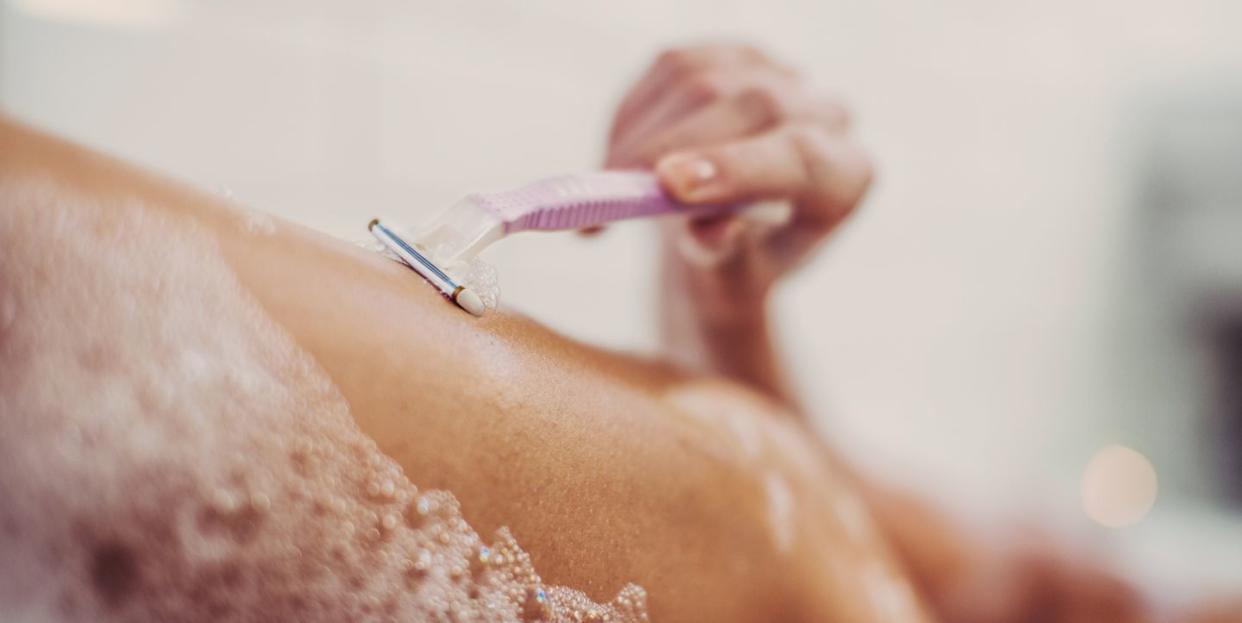The Quickest Way to Get Rid of Razor Bumps

"Hearst Magazines and Yahoo may earn commission or revenue on some items through these links."
No matter how much time and effort we put into shaving, razor bumps can still make an unwelcome appearance. These pesky bumps not only prevent us from achieving smooth skin, but they can also be incredibly frustrating and uncomfortable. So, to get to the bottom of why these bumps form and how to get rid of them—or prevent them from happening in the first place—we spoke with Sai Demirovic, esthetician and co-founder of GLO Spa NY, Lily Talakoub, a dermatologist at McLean Dermatology and Skincare Center, and New York-based dermatologist Elyse Love to find out all there is to know about razor bumps.
Why do razor bumps happen?
"The term razor bump is used to describe two conditions," Love explains. "One is skin irritation that can occur with shaving, particularly when shaving with dull razors and/or without shaving cream. This skin irritation causes a rough and irritated feel to the skin." In addition, "Razor bumps can also describe ingrown hairs that may or may not be visible. Ingrown hairs occur when hair grows into the skin and causes inflammation," says the derm. "This results in red or skin-colored bumps surrounding a hair follicle."
According to Talakoub, razor bumps occur more often in parts of the body that fold, such as the underarms, because of the skin-on-skin contact and the increased moisture that happens in that area. Demirovic adds that razor bumps are common where hair grows the thickest, like the face, neck, bikini area, and underarms. The thicker hairs can cause more irritation and oil production than finer hair, leading to inflammation and possibly even infection.
Demirovic also says hair texture plays a role, and bumps happen more frequently with those who have naturally coarse hair and darker skin tones. "Hair that naturally grows into a curl has a larger risk of getting trapped into the skin than a straight hair can," she says. These bumps can last up to two weeks, which can make it a never-ending battle when you shave frequently.
How do you get rid of razor bumps?
There are a few ways. "Anti-inflammatory ingredients are helpful," Love says. "Over-the-counter hydrocortisone may be good enough, but if it's persistent despite a few days of treatment, it's best to see a dermatologist for a prescription product." Plus, she notes that prevention is key: "Topical cortisone use should be limited in this area, so it's best to take the time to prevent skin irritation by using sharp blades and shaving cream routinely. For ingrown hairs, alpha- and beta-hydroxy acids can be helpful for prevention."
Love recommends Dr. Dennis Gross Skincare's Alpha Beta Exfoliating Body Treatment Peel, Nécessaire's Body Exfoliator, and eos Shea Better Shave Cream, the latter of which "contains moisturizing and anti-inflammatory shea butter and shea oil to support the skin during shaving." Meanwhile, Demirovic likes using iS Clinical Active Serum or the PFB Vanish Razor Bump Stopper Roll On Shaving Gel, which has lactic, salicylic, and glycolic acids to exfoliate the skin above the trapped hair and kill bacteria trapped in the follicle. She then reaches for aloe vera to soothe the area and calm any lingering inflammation.
How can you prevent razor bumps?
When's the last time you changed your razor blade? If you can't remember, it's been too long. Other than using a sharp and clean razor, there are a few other things to keep in mind to make sure you get a close shave without any irritation.
Talakoub says to shave with—not against—the grain and to shave in a steamy shower to soften the hairs. You'll also want to avoid leaving your razor in the shower as the dampness can cause it to gather bacteria and mold. Instead, stash it in your medicine cabinet or toothbrush holder.
As for maintenance, Demirovic suggests mixing vitamin E oil with Cetaphil Moisturizing Lotion to nourish the skin and recommends using a product like Fur Oil for your bikini area. Talakoub also likes Tend Skin Lotion for reducing ingrown hairs and razor bumps.
If you've done all of the above and still commonly see razor bumps, you might want to consider laser hair removal. "It kills the hair all the way down to its root," Demirovic says. "Essentially, if there isn't hair growing, there isn't anything in the way to cause an ingrown hair. Laser can also help reduce the hyperpigmentation and scarring caused by ingrowns."
Can I shave if I have razor bumps?
You should avoid shaving over razor bumps, as doing so can worsen the problem by causing inflammation and irritation that resembles acne, potentially leading to an infection. "Shaving over razor bumps can also be quite painful and only exacerbate the problem," says Demirovic. Instead, consider laser hair removal, which is highly effective in getting rid of ingrown hairs and preventing future razor bumps.
How long do razor bumps take to heal?
Razor bumps can take anywhere from a few days to three weeks to heal on their own. However, re-shaving can aggravate the bumps, leading to further inflammation and irritation. It's recommended to replace razors every month to prevent the worsening of bumps as razors dull over time.
You Might Also Like

